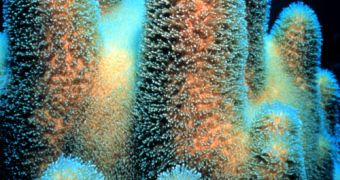Over the past ten years or so, a researcher at the University of Bristol has kept a close ear on the sounds that are produced naturally in and around coral reefs, by fish, urchins and the corals themselves. These noises can be used as indicators of how healthy the reefs are as a whole.
The expert has been focusing his investigations on analyzing the effects of climate change, global warming and ocean acidification on fish and fisheries in various parts of the world.
“Coral reefs produce truly amazing soundscapes,” explains Dr Steve Simpson, a researcher with the UB School of Biological Sciences.
“Snapping shrimps generate a constant crackling sound – which mariners often liken to that of frying bacon – that vibrates through the hull of a boat when anchored near to reefs,” he says.
“On top of this, fish talk to each other with a whole array of pops, grunts and chirps, and urchins scrape away at the reef to feed,” the investigators say.
He adds that these noises work in tandem, combining to create impressive oceanic soundscapes that surround coral reefs for miles. The sounds can be detected by using special underwater microphones called hydrophones.
During his work, Simpson determined that some of the methods and models commonly used by authorities and conservationists in analyzing the dispersal patterns of coral reef fish around their home were incomplete.
As part of his PhD work, he found that some basic biology was missing from established fisheries management strategies, which has significant implications on how regulation to prevent overfishing is applied.
At the time when the investigation began, existing models did not account for the fact that some fish species develop to their larval state away from the reef, sometimes thousands of miles away.
What surprised Simpson was that most of these fish tended to return to the very reef were they had been originally spawned. None of these data were in the past models.
In-depth studies by the UB team found that when fish were mature enough to look for a home, they were attracted to the reef where they were spawned by the specific noise each such ecosystems makes.
“We started by making recordings of reefs and playing them back around traps. We caught more than twice as many larvae in the noisy traps as we did in traps where we played no recordings,” the expert says.
“Then we built artificial reefs and used recordings to attract larvae to recruit to these new sites,” he adds. Data obtained in this matter is currently in use by some nations for testing new fish management strategies where others have failed.
“Since reef noise is produced by the animals that reside there, it offers fish, and marine biologists, an opportunity to eavesdrop on the community,” the expert revels.
“The fish can use it to select the best habitat to live in; for biologists and fisheries managers it provides a totally new tool for monitoring the health of the community,” he says.
Human activity around these reefs modify the natural sounds of the sea, making many fish species disoriented, and unable to return. Pollution and acidification then destroy the reefs from within, replacing them with invading algae and sand.

 14 DAY TRIAL //
14 DAY TRIAL //